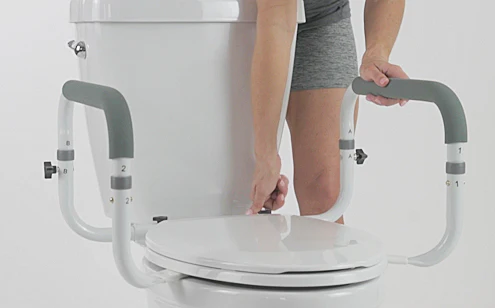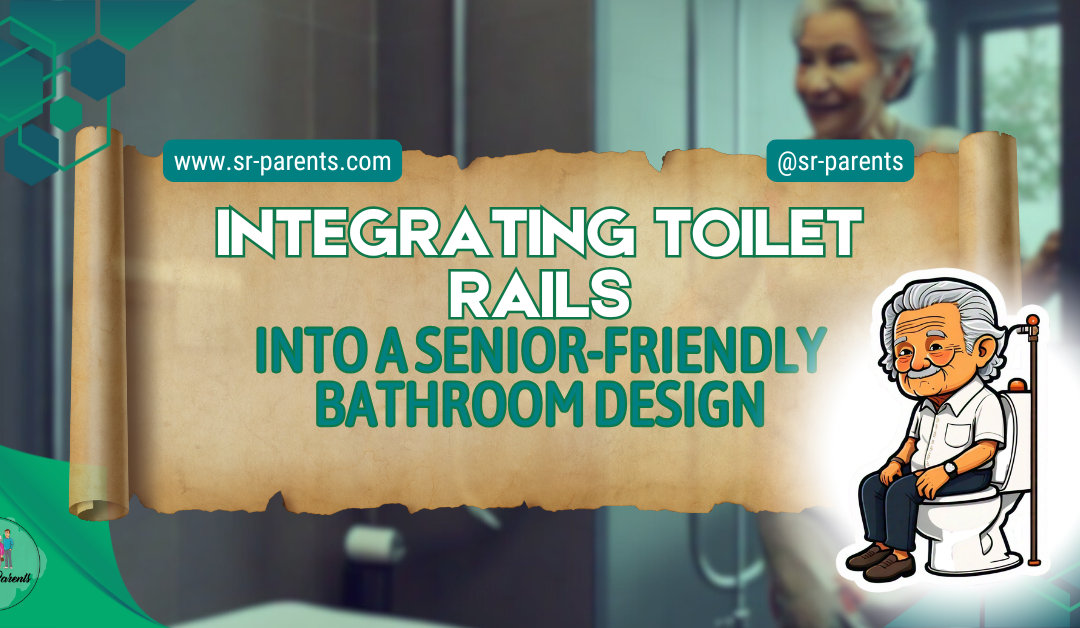Integrating toilet rails into a senior-friendly bathroom design is not just about adding a support feature; it’s about enhancing independence and confidence. These rails provide stability where it’s needed most, reducing the risk of slips and falls that can have serious consequences. For seniors with limited mobility, the addition of toilet safety rails can make all the difference in feeling secure and self-sufficient in their daily routines. A well-designed bathroom isn’t just functional—it becomes a sanctuary where seniors can maintain their autonomy. With thoughtful adjustments, these spaces can help bridge the gap between mobility challenges and independent living.
Creating a bathroom that balances functionality with comfort is key to achieving a supportive environment. Thoughtfully designed toilet rails blend seamlessly into the bathroom, offering support without compromising aesthetics. They come in various styles and finishes, allowing homeowners to create a cohesive look that enhances the overall design. From selecting the right materials to ensuring optimal placement, each detail contributes to a space that is both practical and pleasing to the eye. In this guide, we’ll explore how to choose, install, and integrate toilet rails effectively, transforming a simple bathroom into a safe and empowering space for seniors.
Contents
Creating Senior-Friendly Bathrooms with Essential Toilet Safety Rails for Comfort and Independence

As the population ages, making homes more adaptable for the senior community is a growing priority. Among the many enhancements that bolster safety and independence, toilet safety rails are an essential feature in senior-friendly bathroom design. They provide stability and support, making the bathroom a safer environment for those with reduced mobility. A well-designed bathroom can reduce the risk of falls and injuries, promoting confidence and self-reliance in seniors as they go about their daily routines.
Integrating toilet rails into a senior-friendly bathroom design requires them to be both functional and seamlessly incorporated into the bathroom’s overall layout to ensure they do not become an obstacle or diminish the aesthetics of the space. Choosing the right rails involves considering the strength, height, and ergonomics that will best support the individual user’s needs. The installation process, too, must be approached with precision to ensure that the rails are securely fitted and positioned for optimal support. As bathroom designs evolve to meet accessibility standards, integrating these assistive features in a way that maintains the bathroom’s comfort and style is of utmost importance.
Key Takeaways
Toilet safety rails enhance bathroom safety, providing crucial support for seniors, which promotes their independence and confidence in daily routines.
Choosing the right toilet rails involves assessing individual needs, such as mobility levels and preferences, ensuring the features match the user’s requirements.
Secure and precise installation of toilet rails is vital for stability and effectiveness, with attention to height and positioning to maximize safety.
Toilet rails can be seamlessly integrated into bathroom designs without compromising aesthetics, allowing for a cohesive look with various styles and finishes available.
Regular inspections and maintenance of toilet rails are essential for ensuring long-term safety and functionality, preventing potential accidents and wear over time.
Understanding the Importance of Toilet Rails

Integrating toilet rails into a senior-friendly bathroom design is pivotal for enhancing the safety, independence, and comfort of seniors in their own homes.
Safety Benefits
Toilet rails provide crucial support for the elderly, significantly reducing the risk of slips and falls in the bathroom. They offer a stable grip when transitioning from standing to sitting position or vice versa. The senior-friendly bathroom designs suggest that a safely designed bathroom with appropriate rails can prevent accidents, a common concern in elder care.
Independence and Empowerment
The presence of toilet rails can empower seniors to maintain their independence in personal hygiene tasks. This support is essential for those with limited mobility or strength, as it enables them to use the facilities without assistance, fostering self-sufficiency and dignity.
Did You Know?
The best small bathroom modifications to accommodate aging adults include adding grab rails, a higher toilet seat, and sprayer attachments for showers to provide independence while using the facilities.
Comfort and Convenience
Apart from safety and autonomy, toilet rails contribute to overall comfort. Features like adjustable arm height and width, as noted in descriptions of sturdy and lightweight frames, cater to individual needs, ensuring a comfortable and accessible bathroom experience.
Easy installation and maintenance of these rails further add to the convenience for both users and caregivers.
Designing for Senior Needs
Integrating toilet rails into a senior-friendly bathroom design requires careful consideration of seniors’ mobility and physical strength. It’s paramount to tailor features that ensure safety, ease of use, and comfort.
Assessing Mobility and Strength
When considering updates for a senior-friendly bathroom, one should evaluate the individual’s mobility level and strength. Assessing the degree of support needed is crucial for choosing the appropriate toilet safety rails. A person who relies on a wheelchair or walker, for instance, demands different specifications than one who has mild balance issues.
Space Considerations
Senior-friendly bathrooms must provide ample space for maneuvering. This includes the area around the toilet, which should allow for easy access and support. To facilitate this:
The space beside the toilet should be at least 36 inches wide to accommodate a wheelchair or walker.
Clearance in front of the toilet should also be adequate for a person to turn around, commonly at least 60 inches of turning radius.
Height and Positioning of Rails
Selecting the right height and position for toilet safety rails can significantly reduce the risk of falls. The rails should be installed:
At a comfortable height, generally between 34 and 38 inches, depending on the user’s arm reach and strength.
Close enough to the toilet to provide effective support but not hinder transfer from a mobility device.
Choosing the Right Toilet Rails

Selecting suitable toilet rails is a decision that affects both safety and comfort when integrating toilet rails into a senior-friendly bathroom design. Critical factors include whether the rails are fixed or adjustable, their construction materials, and their weight capacity.
Fixed vs. Adjustable Rails
Fixed Toilet Rails are permanently attached to the wall or floor, offering stability and reliability. They are best used when the user’s mobility needs are unlikely to change.
On the other hand, Adjustable Toilet Rails afford flexibility and can be tweaked to accommodate different users or removed when not needed. Products like the Drive Medical Safety Rail provide easy mountability and handle adjustability.
Materials and Durability
Toilet rails are made from various materials, each with its benefits. Stainless steel is highly durable and resistant to corrosion, making it a long-lasting option. Aluminum is lightweight and also resistant to corrosion, but may not be as strong as stainless steel.
Plastic components may be involved in the design for comfort, though they should be checked for sturdiness. The Carex Health Brands FGB rail is an example of a durable, easy-to-assemble unit.
Weight Capacity
The weight capacity of toilet rails is a crucial safety consideration. It’s essential to select a rail that can comfortably support the user’s weight. Most toilet rails are built to support at least 250 pounds, but it is possible to find models like the Secure and Reliable Options that can accommodate more. Always verify the weight capacity before purchasing to ensure it meets the user’s needs.
Watch this video featuring the top 5 best toilet safety rails for 2024.
By: Review Click
Installation Process
Integrating toilet rails into a senior-friendly bathroom design is essential for enhancing accessibility for seniors. The installation process involves careful planning, the right tools, and following specific steps to ensure safety and stability.
Tools and Hardware Required
Measuring Tape: For precise measurements of installation points.
Level: To ensure rails are installed evenly.
Stud Finder: Critical for locating supports within the walls for a secure mount.
Drill: With the appropriate drill bits for wall material.
Screws and Anchors: Heavy-duty options that match the rail system and wall construction.
Wrench or Screwdriver: Depending on the rail system’s mounting hardware.
Step-by-Step Guide
Identify Installation Points: Use the measuring tape to decide the height and position on the wall for the safety rails.
Locate Wall Studs: With the stud finder, pinpoint where to securely anchor the rails.
Mark Drill Points: Using the level, mark the precise spots for drilling holes for brackets or anchors.
Drill Holes: Carefully drill into the marked positions.
Install Anchors: If not drilling into studs, place wall anchors to secure the screws.
Mount Rails: Align the rails with the holes and secure using the provided screws.
Check Stability: Ensure the rails do not move and can support the anticipated weight.
Professional vs. DIY Installation
Professional Installation: Recommended for those who value guarantees of correct installation and can afford the service cost.
DIY Installation: An option for individuals with experience in home improvements who have the necessary tools and confidence to ensure a safe installation.
Maintaining Toilet Rails

Maintaining toilet rails is essential for ensuring safety and longevity, especially when integrating toilet rails into a senior-friendly bathroom design. This entails regular inspections, thorough cleaning, and timely repairs or replacements.
Regular Inspection
Toilet rails should be inspected monthly to ensure they remain secure and stable. One should check for loose fittings, corrosion, and any signs of wear that could compromise their integrity.
Stability: Shake the rails gently to test for wobble or movement.
Fittings: Examine screws and brackets for any signs of loosening.
Cleaning and Hygiene
Regular cleaning prevents the buildup of harmful bacteria and extends the life of toilet rails. It’s important to use non-abrasive cleaners and soft cloths to avoid scratching the surfaces.
Sanitization: Use a disinfectant to regularly wipe down all surfaces.
Material Care: Apply anti-corrosion products if recommended by the manufacturer.
Repair and Replacement
Damaged parts should be repaired or replaced immediately to prevent accidents. Always use manufacturer-approved parts for replacements to ensure compatibility and safety.
Parts: Review the manufacturer’s guidelines for specific part numbers and instructions.
Professional Help: Consider hiring a professional for complex repairs to guarantee proper functionality.
Accessibility Standards and Compliance
Incorporating toilet safety rails within a senior-friendly bathroom requires adherence to specific accessibility standards and compliance with local codes. Integrating toilet rails into a senior-friendly bathroom design ensures the environment is both safe and functional for seniors, which is paramount.
ADA Guidelines
The Americans with Disabilities Act (ADA) provides comprehensive guidance on making public facilities accessible to individuals with disabilities, which can be applied to residential bathroom designs. Toilet safety rails, under ADA standards, must have specific features:
Height: Between 34 to 38 inches above the floor
Structural Strength: Must withstand a minimum of 250 pounds of force
Space Around Toilet: At least 60 inches diameter for wheelchair turning radius
Local Building Codes
Local building codes may have additional or differing requirements for bathroom safety features. It’s crucial to check with local authorities to ensure that the installation of toilet safety rails meets all regulatory obligations. One should note that:
- Variations: Variations exist between jurisdictions; some may require inspections or permits
- Materials and Installation: Codes often specify types of materials and methods of installation to enhance durability and user safety
Incorporating Aesthetics

When designing a senior-friendly bathroom, aesthetics are not just about visual appeal; they ensure that safety features like toilet rails complement the overall decor. Integrating toilet rails into a senior-friendly bathroom design should feel seamless, maintaining a warm and homely atmosphere while serving a practical purpose.
Matching Decor
In the context of toilet rails, selecting ones that match the existing bathroom decor can create a cohesive look.
Manufacturers offer a variety of finishes such as chrome, brushed nickel, and bronze, which can pair well with common bathroom fixtures.
Additionally, one can find rails with different materials and textures that can either stand out as a statement piece or blend in subtly with the bathroom’s style.
Concealed Mountings
Concealed mountings contribute to a streamlined aesthetic by hiding screws and mounting hardware. This not only enhances the visual appeal of the safety rails but also eliminates potential discomfort from exposed hardware. Installation should be done by professionals to ensure that the rails remain secure and functional.
Take a look at this video on toilet safety rails.
By: It’s the Dave Show
Enhancing Independence: The Vital Role of Toilet Rails in Senior Bathrooms
Integrating toilet rails into a senior-friendly bathroom design significantly enhances both safety and independence for seniors. These vital features provide the necessary support, making daily activities easier and reducing the risk of slips and falls. By offering a stable grip for seniors as they navigate the bathroom, toilet rails empower them to maintain their self-sufficiency and dignity. This thoughtful addition transforms an ordinary bathroom into a secure and inviting space that fosters confidence in personal care routines.
Moreover, the design and aesthetics of the bathroom can coexist with functionality. The integration of toilet rails can be accomplished without sacrificing the bathroom’s visual appeal. With a variety of styles and finishes available, homeowners can select options that complement their existing decor while providing essential support. By prioritizing both safety and design, families can create a bathroom that not only meets the practical needs of seniors but also serves as a comfortable and enjoyable environment for all users. In doing so, they take an important step toward ensuring that seniors can thrive in their living spaces with the utmost comfort and confidence.
Frequently Asked Questions
In designing a senior-friendly bathroom, it is crucial to consider features that ensure safety and accessibility to accommodate aging individuals effectively.
What Are Essential Features to Include in a Senior-friendly Bathroom?
A senior-friendly bathroom should include non-slip flooring, well-lit areas, grab bars near the toilet and shower, as well as lever-type faucets and a raised toilet seat for easy use.
How Can One Ensure Safety for Elderly Individuals When Designing a Bathroom?
Safety can be enhanced by installing toilet safety rails, using anti-slip mats, and clearly marking hot and cold water handles to prevent scalding.
Are There Specific Walk-in Shower Features Recommended for Senior Safety?
For senior safety, it’s recommended to incorporate a walk-in shower with non-slip flooring, a bench or seat, and strategically placed grab bars to ensure stability.
What Financial Aid Options Are Available for Seniors Remodeling Their Bathrooms?
Seniors may access grants, loans, or other programs provided by government and non-profit organizations designed to assist with the costs of remodeling for accessibility.
How Can Accessibility Be Maximized in a Bathroom for Someone With Limited Mobility?
Maximizing accessibility involves ensuring clear paths for wheelchairs or walkers. It also involves installing lower sinks and providing easy-to-reach storage to make the bathroom functional for someone with limited mobility.
Stay in Touch With Us
Are you ready to embark on a journey of compassion and knowledge? Engage with us on social media for heartening stories, expert insights, and crucial advice on caring for seniors!
? Website: Visit sr-parents.com for comprehensive articles and resources on senior care, health, and wellness.
? Pinterest: Unearth a treasure trove of caregiving ideas, home solutions, and senior-friendly activities at pinterest.com/seniorparents.
? Facebook: Become part of our nurturing community at facebook.com/sr.parents. Connect with fellow caregivers, share your experiences, and find encouragement.
? Twitter: Follow us on twitter.com/senior_parents for timely updates, news, and trending discussions about senior care.
? Instagram: Explore instagram.com/seniorparents for inspiring moments, caregiving advice, and a glimpse into the lives of seniors and their families.
Stay connected, uplifted, and informed with our latest articles and heartwarming stories on senior care.





